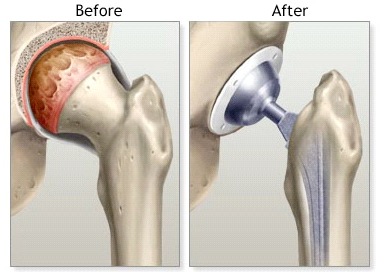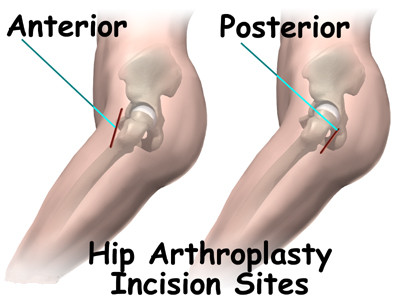 Hip replacement surgery is a common occurrence. The surgeon will make an incision in the side or back of the hip to detach the tendons and muscles, so that the joint can be replaced. However, if the muscles do not heal properly after surgery, your risk of hip dislocation and a failed surgery increases. So, you need to perform proper precautions to reduce the pain and help with a quicker recovery. Read on to find out proper hip replacement precautions you need to know.
Hip replacement surgery is a common occurrence. The surgeon will make an incision in the side or back of the hip to detach the tendons and muscles, so that the joint can be replaced. However, if the muscles do not heal properly after surgery, your risk of hip dislocation and a failed surgery increases. So, you need to perform proper precautions to reduce the pain and help with a quicker recovery. Read on to find out proper hip replacement precautions you need to know.
When to Have a Hip Replacement Done
The most common reason for having hip replacement surgery is osteoarthritis. However, if you have had any hip joint damage or severe pain that interferes with your daily routines, you may also have a hip replacement. Some other common reasons for having hip replacement surgery include:
- Rheumatoid arthritis
- Hip injuries
- Fractures in the hip bones
- Tumors in the bones that cause the hip joint to deteriorate
Hip Replacement Precautions
 1. Posterior Hip Precautions
1. Posterior Hip Precautions
- Avoid any bending or twisting that requires you to bend further than 90 degrees. You may need to have raised toilet seats and chairs to make sure you don't bend too far when you sit, as well.
- Keep your hip from rotating inward while it is healing. Keep your knee from turning inward. You need the help of someone else to do the things that require you to twist and reach for items.
- Keep your legs from crossing the middle of your body. Do not cross your ankles or knees, and you may need to use a pillow between your knees when you sleep. Also, do not bring your knees together, and do not lie on the hip that had surgery.
2. Anterior Hip Precautions
- Do not make hip to turn outward. This means that you need to keep from twisting across your body, ensure that you walk with your feet facing front, and not pivoting on the leg which had the surgery.
- Avoid extending your operated hip backward. Use the leg that did not have surgery first when stepping backward and take small steps when walking to avoid the hip from bending too far back as you place your weight on a walker or crutch instead of your operated leg.
3. Care for the Wound
As one of the hip replacement precautions, you need to always keep the wound dry and clean while following your doctor's instructions. You may need to change the bandage often and wait a few days before showering or bathing. If it seems infected, let your doctor know timely.
4. Reduce the Swelling
Considering that you are practicing proper precautions, you will still experience certain level of swelling for about three to six months. Elevate in a slow and slight motion, then ice your hip to reduce any swelling. For any severe or new swelling, just call your doctor to rule to the possibility of blood clot.
5. Take the Medications on Time
Always take medications as prescribed. Stopping too early or missing a dose may affect your recovery. Some antibiotics will be prescribed when there is an increasing chance of getting infected bacterially.
6. Daily Activities
|
Activities |
How to Perform |
|---|---|
|
Arrange daily items |
Organize the items that you use daily and your furniture in a way that makes them easy to get without bending, twisting, and injuring yourself. Also use the previous precautions to make sure you have everything you need to follow them. |
|
Standing |
Use the leg that did not have surgery and your arms to lift you out of the seat. |
|
Going up & down stairs |
One of the hip replacement precautions that may be ignored is when climbing stairs, move slowly. When going up, use the non-operated leg as the lead, when coming down use the crutch and operated leg as the lead. Use your arms to lift and have family member stand one step below you. |
|
Getting into & out of a car |
Slide and recline the seat all the way back. Hold onto your walker as you back into the seat, then swing your legs around, leaning back to keep your hip from bending too far. Reverse this action to get out of the car. |
|
Getting into & out of a bed |
Always remember to keep your operated leg straight so that you do not use it to lift. Using your hands slide it into the bed while leaning back so that your hips do not pass 90 degrees. Reverse the process to get out of bed and lift with your non-operated leg and arms. |
|
Lying in bed |
Make sure you keep a pillow or pillow wedge between your legs. You do not want your knees touching or your legs crossing while you sleep. If you must sleep on your side, sleep on the side that was not operated on and use a pillow or wedge between your legs. |
|
Dressing |
Sit on a chair and slowly dress yourself, making sure that you do not bend your hips too far. Dress the operated leg first. You may also find that having someone help you works best. |
|
Bath and shower |
If you are going to sit, use a chair, do not bend or squat to grab items as you wash. Make sure you use a mat to avoid slipping. |
7. Additional Precautions
You do not want to use the muscles of the hip too soon after surgery, sometimes a leg lifter will help.:
